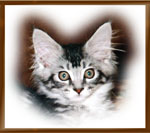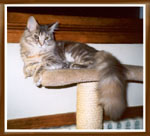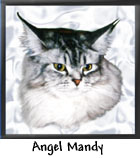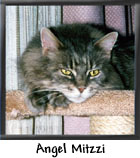Table of Contents
Assist Feeding – Buddy and his HL Experience
Feline Nutrition – Getting Involved
Pro-Active Cat Care – Feline Aggression
Feline Obesity – Derriere Care
Kitty Potpourri – Introducing Ourselves
Message from the Editor
We have a new writer on board this week! Be sure to meet Dan and his crew in the article Kitty Potpourri! Welcome Dan!
Assist Feeding – Buddy and his HL Experience
by Kathy Fatheree
Petie and Buddy are avid readers of our newsletter and here is a short diary of their experience when Buddy came down with Feline Hepatic Lipidosis (fatty liver disease). Buddy weighed almost 23 lbs before FHL!
The schedule of events was this:
Jaundiced late Wed., Nov.5
Diagnosed with FHL & hospitalized Thursday, Nov. 6
Syringe-fed orally at hospital Nov.6 through Nov 13 (most thrown up)
Esophageal tube implanted Thursday, Nov. 13
Saturday evening, Nov. 15, we brought him home and continued syringe-feeding via tube (not eating on his own at ALL)
Saturday morning, Nov. 29, Buddy THREW UP the inner end of the tube. I kid you not! (It rarely happens, but I “pushed the envelope” amount-wise, he jumped down off the bed and threw up!) We rushed to the vet, where they removed the remainder of the tube (he had bitten it off!). They scheduled surgery to implant a new tube the next morning (Sunday) but Buddy began eating on his own at Midnight Saturday night and has done so ever since!
Although it seemed like YEARS, he went from being severely jaundiced and not expected to live, to doing without the tube, in only THREE weeks! Once the tube was implanted and he was getting more A/D in him (and NOT throwing up as he did with oral syringing) his jaundice disappeared in about 10 days!!! THAT is the beauty of tube-feeding! I (and my vets) think Buddy would surely have died without the benefit of tube-feeding! The tube feeding was much easier than oral syringing, and obviously more effective!
Feline Nutrition – Getting Involved
by Garry White
If we were to take a test concerning proper diet for our kitties, how many of us would get a passing grade? Not many, I bet, and I’d be struggling right along with everyone else. I guess the only small advantage I might have is that I’m forced to do nutritional research in order to write these articles, and I can tell you with my soul that it’s enlightening and alarming. Prior to my in-depth involvement here, I bought the best of whatever was available –and convenient. Yes, I knew about a specialty pet-food store (on the other side of town), but let’s be practical about this: Reputable manufacturers aren’t going to produce foods that are harmful, right? And my guys LOVED that Sliced Chicken & Gravy, so what’s to worry? I mean.they eat well, and anyone can see they’re healthy little creatures. Besides, it’s raining, I’ve got the dry cleaning to pick up, a few other errands to tend to, dinner to fix.yeah, yeah; I’ll check out that pet-food store next week. Or maybe the week after. Or soon. But right now it’s not a crisis, and dinner is. Sound familiar?
I think most of us are conscientious pet-parents, and we really do try to do the right thing in managing our kitty’s diet. But sometimes we fall to indifference, as I did for so many years: My guys were in tip-top shape (or so I thought), they loved the food, and it came from a reputable manufacturer. So it’s probably okay.
Then again, maybe it’s not okay. Nutritional science has come a long way in the past few years, and it’s proven beyond a shadow of a doubt that proper diet can extend our kitty’s life by years! Knowing this, I wish had had let ‘next week’ become ‘this week’. We can’t turn back the clock, but we can take advantage of what’s available to us now. The truth is, there are tremendous differences between foods, and manufactures are required to meet nutritional standards that allow them to legally say “Your cats can live on this food alone”. Sure they can, but for how long?
If you’re of my old mindset (buy a good name food that they like, and it should be okay), then I’m talking to the wind. But I don’t think you are; I think most of us left the “old Garry” back in the dark ages where he belongs, and most of us wish to keep Fluffy around for as long as possible. And I think must of us realize that a good diet will help us accomplish that. Next week will be a long one, so be prepared with a sharp mind and a readiness to get involved! I’m going to break down two foods from different manufacturers and show you what’s really in that can. We’ll use our Nutritional Calculator to show excesses (and deficiencies) of specific nutritional ingredients, and we’ll try to tell you how those differences affect your cat’s system.and I bet you’ll find the results startling. Don’t miss it!
ProActive Cat Care – Feline Aggression
by Garry White
Fluffy, you’re ruining my social life with your aggressive ways. I go to a party hoping for romance, but instead, the girls are merely fascinated with that Cleveland street-map on the side of my face.aka paw-tracks. I could show them what you’ve done to my leg, but they’d probably slap me good right on Broadway! We have to do some serious negotiating, you and I.
Feline aggression can stem from any number things, and we’ll talk about a few; but the bottom line is that it’s socially unacceptable (if you have a teenager in the house, you can relate to this). A cat, as with any other member of the domicile, must be taught the rules of the house. There are proper and improper ways to manage this, and the most improper way of all is with anger. The most proper and effective way is to understand that Fluffy is, after all, a cat. Threats don’t work: “Okay, one more scratch and no MTV for a week!” Nor will delayed punishments be effective; corrections must happen at the time of the offense, or a cat cannot relate the punishment with the offense. The secret to managing feline aggression is the exact opposite of what we do with teenagers (and husbands): Be prepared to enforce a guideline when you have to, and be prepared to hand out rewards when they follow the beaten path.
Hubby: “Honey, I fixed that squeaky door!”
Wifey: “And after only 6 months of my begging. I’m truly impressed.”
What makes a cat become aggressive? Well, assuming her tail isn’t closed in the door (as I did with Clark recently!), aggression could come from a number of sources. It could simply be a tendency of the breed (Siamese, for example, are known for their feisty attitudes). Perhaps it’s a product of what you found amusing when she was a kitten: “Oh look, Honey! She’s trying to bite my finger off; isn’t that adorable?” Well, now that she can bite you’re finger off, it isn’t quite so entertaining. Fluffy may have assumed a cantankerous role because she’s in pain; a trip to the vet isn’t out of line if her funky moods are somewhat recent. Or perhaps you’ve introduced other members to the household (other humans, other pets), or you’ve changed her lifestyle in some way, and she’s letting you know that she’s upset by it. And here’s a natural cause: Maybe she has determined that she’s the dominant one, simple as that; remember that cats do have personalities, and as with any group –human or animal– somebody will assume leadership.
No matter what the root cause, it needs to be corrected, and I’m going to refer you to some folks who know a great deal more about this than I do. If you have a chompy felis in your midst, I strongly encourage you to go visit these links; they offer a wealth of informative ideas. Until then, a little First Aid Cream will help to dissolve that Ocean Boulevard running down the side of your arm.
On the Net:
CLICK HERE for Some real-life stories. I enjoyed this site!
CLICK HERE to see how Cornell University views feline aggression.
SAY WHAT? A cure for feline aggression? Get outta town!
A VERY ‘TOGETHER’ SITE.solid information and some pretty cool ideas!
Feline Obesity – Derriere Care
by Kathy Fatheree
Have you ever noticed… fat cats don’t seem to groom themselves as much as sleek cats… hum…
That big ol’ belly is in the way and it’s impossible to bend around! The worst part of being too large to groom is that fat cats cannot reach their… um… their derriere… their hind quarters… you get the picture right? Some cats will ‘scootch’ when irritation exists, yet others do nothing. Phoebe used to continuously chew the tops of her front legs until they were raw. Two different vets said she had allergies and wanted to prescribe a host of medications. I came home and seriously thought about the situation, checked her out from tip to tail, and discovered she had a little poop ball on her rear.
When a kitty cannot reach his or her rear, medical problems can arise from not being clean. Poop particles, moisture and oils build up and are a breeding ground for bacteria. Sores and infections may likely occur.
Until you can help your cat lose weight, you will need to be a cleaning nurse as well. I started washing Phoebe’s rear on a weekly basis… a tasks my vet said would be impossible. Even though she growls and hisses… she has never scratched or bitten me. She is accustomed to our routine by now, and she no longer chews her front legs.
Here is a list of our Cleaning Supplies and Tips to Bathe the Backside:
- A pre-filled sink of warm water.
- Non-slip bath rug placed on the bathroom sink to set kitty on.
- Flea comb to comb out larger particles.
- Tissue to wipe away oils.
- A few drops of baby shampoo lathered on a thin wash cloth.
- Rinse wash cloth in warm water.
- Rinse fur until no soap remains.
- Dry rear with cloth or tissues, and if kitty doesn’t mind, try the hair dryer set on the lowest setting and held at least 12-inches away!
- Oh yes, and be sure to close the bathroom door during this entire adventure!
Kitty Potpourri – Introducing Ourselves
by Dan Malenski
My name is Dan. My kitty Amanda and I will be writing a weekly column on a variety of diverse topics ranging from administering pills (“Not to Me you Don’t!”) to scratching posts.
This week’s column serves exclusively to introduce everyone to the entire family.
First, here’s a picture of me. I’m a hard worker and I  always insure that the kitties have fresh food and water, I keep them warm and cozy, and am always worrying about them, so they have decided to keep me – lucky for me!
always insure that the kitties have fresh food and water, I keep them warm and cozy, and am always worrying about them, so they have decided to keep me – lucky for me!
 This is Amanda, the outspoken one of our family and my walking, talking Valentine, having been born on St. Valentine’s Day of the year 2003. This picture was taken when Amanda was just a little girl (3 months old), and is one of my favorites.
This is Amanda, the outspoken one of our family and my walking, talking Valentine, having been born on St. Valentine’s Day of the year 2003. This picture was taken when Amanda was just a little girl (3 months old), and is one of my favorites.
Next is Amanda’s “sister”, Melissa.  Not really sisters, as Melissa was born on St. Patrick’s day of the year 2000 (does anyone see a trend here?), but they behave like sisters and love each other. Melissa is like me, quiet and the intellectual type, and she will be providing technical support to the column.
Not really sisters, as Melissa was born on St. Patrick’s day of the year 2000 (does anyone see a trend here?), but they behave like sisters and love each other. Melissa is like me, quiet and the intellectual type, and she will be providing technical support to the column.
Finally, here are our two “Angel” kitties. They will be monitoring this column from a distant land:


Each week, my family and I will be writing about items that we believe will interest you and contribute to the well-being of your kitties. Let’s have some fun!
Disclaimer: Kathy Fatheree is not at all a medical expert. Contents of this web site are a collection of Kathy’s assist feeding experiences as well as the experiences of other cat owners who have assist fed their cats. While every effort has been made to ensure the accuracy of the information, Kathy Fatheree or anyone associated with this web site cannot be held responsible for anything that may happen as a result of using the information on this site.
